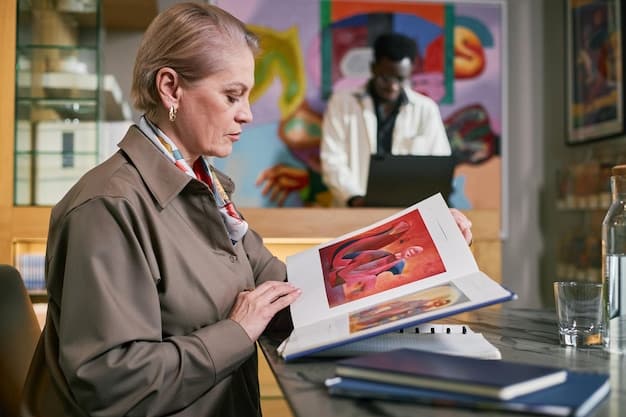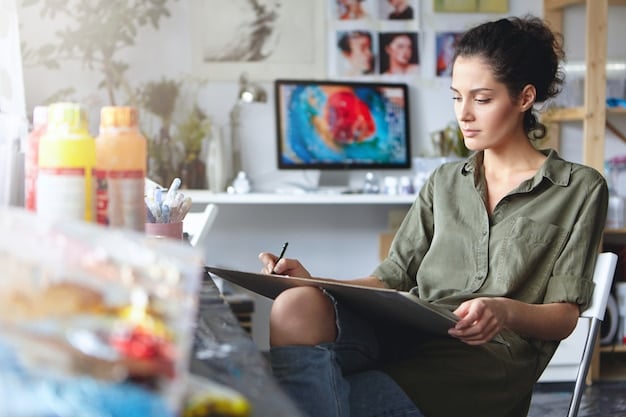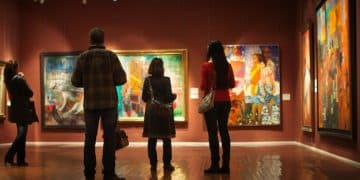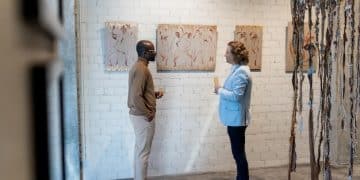Get Your Art Featured: Insider Tips for US Galleries

Getting your art featured in a major US gallery involves networking, presenting a cohesive body of work, understanding gallery preferences, and persistence. This guide offers insider advice on how artists can increase their chances of success.
Are you an artist dreaming of showcasing your work in a prestigious US gallery? Understanding the art world’s landscape and the specific criteria galleries use is crucial. This article provides how to get your art featured in a major US gallery: insider advice, guiding you through the essential steps.
Understanding the US Art Gallery Landscape
Navigating the US art scene requires knowledge of its diverse gallery ecosystem. From established venues in New York City to emerging spaces in Los Angeles and Miami, each region has its own distinct characteristics and style preferences. Researching galleries that align with your artistic vision is the first crucial step.
Types of Galleries in the US
The US art market includes a variety of galleries. Commercial galleries represent artists and sell their work. Co-op galleries are artist-run, providing exhibition opportunities and shared responsibilities. Nonprofit galleries focus on education and community engagement, often showcasing experimental art.
- Commercial Galleries: These galleries aim to sell art and generate profit. They typically represent established and emerging artists.
- Co-op Galleries: Run by artists, these galleries offer a platform for members to exhibit their work and share operational duties.
- Nonprofit Galleries: Focused on art education and community outreach, these galleries may showcase diverse and experimental works.
Understanding the different types helps you target your submissions effectively. Prioritize galleries known for representing artists in your genre and at your career stage.

Building a Strong Artistic Portfolio
Your portfolio is your artistic identity. A well-curated collection that displays your unique style, technical skills, and artistic journey is essential. Your portfolio has to communicate a singular vision, not a series of random experiments.
Key Elements of a Portfolio
Your portfolio should feature your best work, presented professionally. Quality over quantity is vital, highlighting consistency and depth. Include a compelling artist statement explaining your inspiration, process, and artistic goals.
- High-Quality Images: Use professional, well-lit photographs or digital scans of your artwork.
- Artist Statement: Write a clear, concise statement outlining your artistic philosophy and process.
- Curated Selection: Choose a selection of pieces that represent your strongest and most cohesive work.
Galleries want to see where you are headed, not just where you’ve been. The more consistently strong your work is, the more likely a gallery is to feel confident representing you.
Networking and Building Relationships in the Art World
Networking is paramount for artists seeking gallery representation. Building relationships with curators, other artists, and art critics grows your network and opens opportunities to get your work seen. Attending art openings, workshops, and talks fosters this connection.
Strategies for Effective Networking
Networking in the art world requires genuine engagement. Be prepared to discuss your work, listen to feedback, and offer support to your peers. Personal connections often lead to collaborations, referrals, and even gallery representation.
- Attend Art Events: Regularly visit gallery openings, art fairs, and museum events to meet industry professionals.
- Engage on Social Media: Use platforms such as Instagram and LinkedIn to connect with artists and curators.
- Join Art Organizations: Participate in local art groups and organizations to expand your reach.
Networking does not have to feel like self-promotion. Genuine interaction with art professionals is a good way to build long-lasting relationships.
Approaching Galleries with Your Art
Submitting your art to a gallery requires careful planning. Direct, personalized approaches that demonstrate your understanding of the gallery’s style and audience are most effective. Generic submissions often get overlooked.

Perfecting Your Submission Package
Your submission package should include a cover letter, artist statement, portfolio, and CV. Tailor each element to resonate with the specific gallery. Mention specific pieces that directly complement the ethos of the institution.
- Cover Letter: Introduce yourself and explain why you believe your work aligns with the gallery.
- CV/Resume: Provide a brief overview of your artistic training, exhibitions, and achievements.
- Portfolio: Include a selection of your strongest work that matches the gallery’s aesthetic and focus.
Galleries appreciate professionalism and attention to detail. A well-prepared package that speaks directly to the gallery’s mission shows that you have invested time and effort into understanding their unique perspective.
Understanding Gallery Expectations and Preferences
Understanding what galleries expect from their artists is crucial. Professionalism, consistent output, and a collaborative attitude are essential. Building a strong relationship with your gallery is important for long-term success.
What Galleries Look For
Galleries seek artists who are not only talented but also reliable and easy to work with. Consistent creation of high-quality work, active involvement in gallery events, and the ability to meet deadlines are all essential qualities.
- Professionalism: Galleries value artists who are punctual, respectful, and communicative.
- Consistent Output: Creating a steady stream of high-quality work ensures a continuous supply for exhibitions.
- Collaborative Attitude: Maintaining open communication and collaborating on marketing and promotion activities strengthens the artist-gallery relationship.
Galleries are not just looking for great art; they are also looking for partners who will contribute proactively to the success of the gallery. Demonstrate your dedication and willingness to collaborate effectively.
Persistence and Patience in the Art World
Getting your art featured in a major gallery requires perseverance. Rejection is a normal part of the process, and artists must be prepared for setbacks. Maintain a positive attitude and continue to develop your work.
Strategies for Handling Rejection
Rejection should serve as motivation to grow. Use feedback to improve your work and your submission strategy. Persistence, combined with continuous self-improvement, can lead to success.
- Seek Feedback: Ask respected peers and mentors for constructive criticism.
- Stay Positive: Maintain a positive attitude and continue creating and refining your work.
- Adapt and Improve: Use rejection as a learning opportunity to refine your approach.
Remember that every successful artist has faced rejection. What sets them apart is their resilience and unwavering commitment to their craft.
| Key Point | Brief Description |
|---|---|
| 🎨 Portfolio Quality | Showcase your best, most cohesive artwork. |
| 🤝 Networking | Attend events, connect with curators. |
| ✉️ Submission Strategy | Tailor your approach to each gallery. |
| 💪 Persistence | Don’t give up; keep creating and improving. |
FAQ
▼
A standout portfolio showcases high-quality work, a cohesive theme, and technical proficiency. It should also demonstrate the artist’s unique vision and artistic voice.
▼
An artist statement is very important. It provides insight into your inspiration, process, and the message you aim to convey. A well-written statement enhances the understanding of your art.
▼
Follow up politely after a reasonable time. If you don’t hear back, it’s okay to move on, but always be respectful and keep improving your work for the next opportunity.
▼
Research galleries online, attend art fairs, and visit local exhibitions. Pay attention to the artists the gallery represents and their curatorial focus to find a good fit.
▼
While living in a major art hub can offer more networking opportunities, it’s not essential. Building connections online and through travel can also lead to gallery representation.
Conclusion
Securing gallery representation requires a combination of talent, dedication, and strategic planning. By building a strong portfolio, networking effectively, and understanding gallery expectations, artists can significantly increase their chances of success in the competitive US art market.





